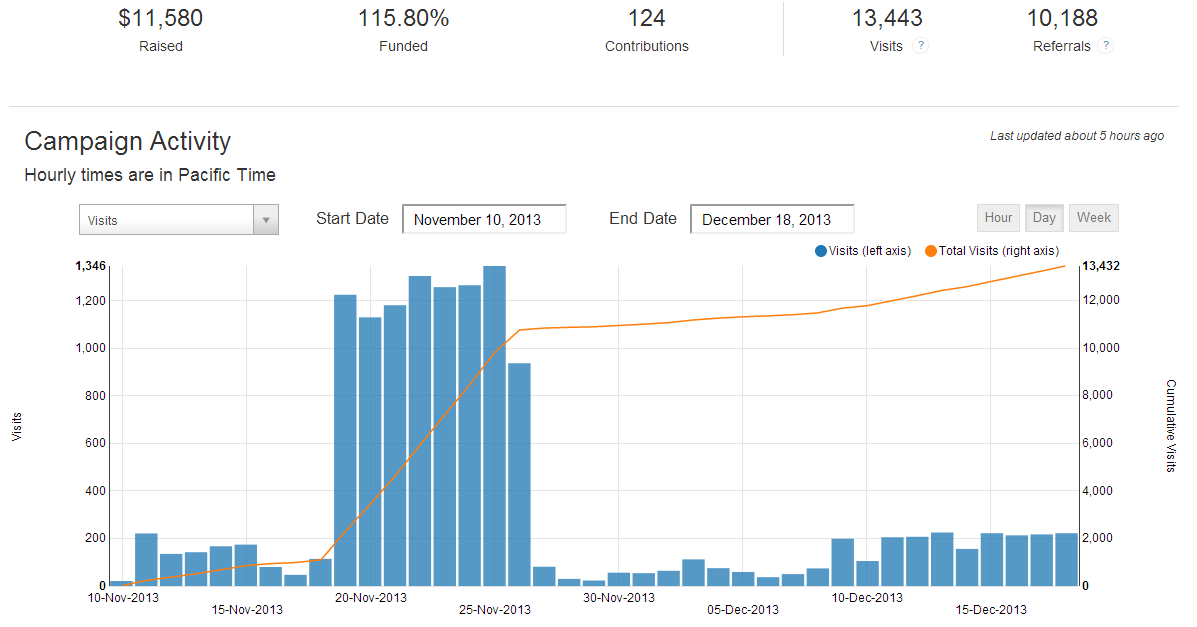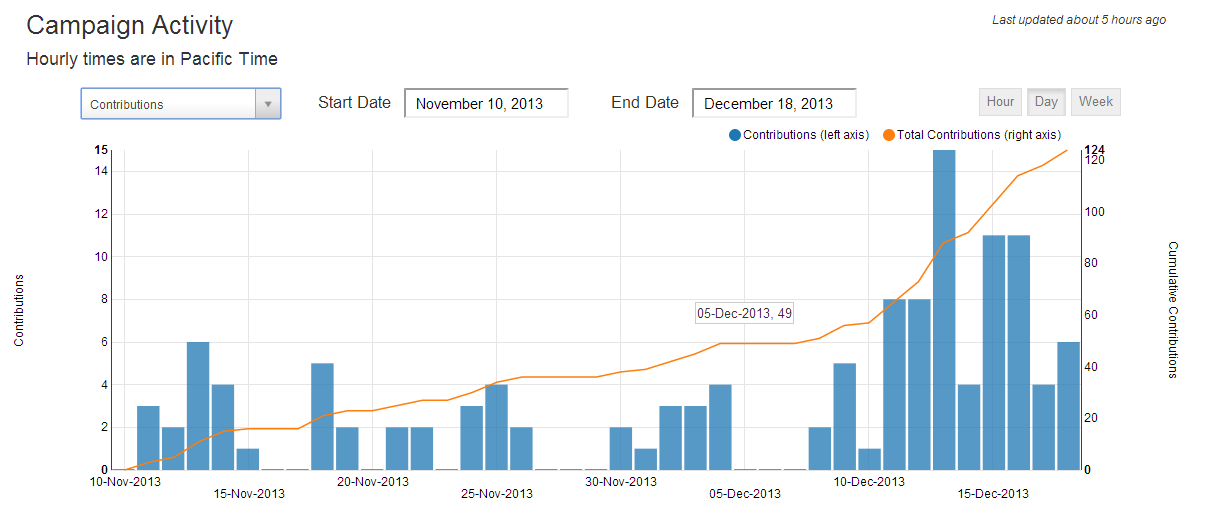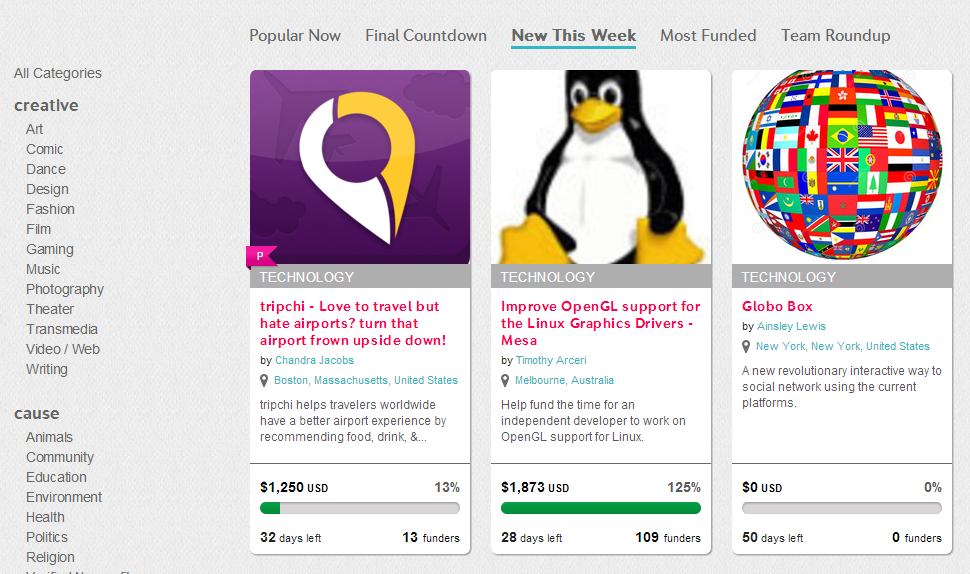Thinking about launching a crowdfunding campaign? Great, because that’s what this blog is all about! Before you dive in to your campaign full-throttle, keep reading for some tips, tricks, and lessons learned, that I’ve collected throughout my tripchi Indiegogo campaign journey, which ended mid-December 2013.
Why crowdfunding, why now? For my startup tripchi, we came to a point in our product development where we hit a resource wall. We needed to augment our internal dev team with outside resources to simply speed up the pace that we were building at (most of our team is part-time). We’re too early-stage still to raise a seed (because we don’t have a public release yet), and we’ve already burned through our internal investment money to get where we are today. At the same time, we wanted to validate the concept with our customer base, generate interest, brand awareness, and create early product evangelists and adopters. Moreover, we wanted to learn a ton from our customers and test out the mechanisms of our marketing strategy and product message. Indiegogo was therefore the perfect fit. If you’re in a similar situation, it may also be a good fit for you. Just be clear about what your goals are and try not to make them unrealistic – achievability and clarity of purpose and necessity are key.
Our goal is to raise $10,000 (which, in retrospect, is fairly ambitious), which will cover the build out of at least 3 airports (that the Indiegogo community votes for). The more we raise above this figure, the more airports and specials features, deals, and offers, we can include in the app for Indiegogo tripchi supporters. We will also give supporters access before anyone else to the app once it’s built, and engage with them every step of the way throughout our product development and testing process. Most importantly, we want our early supporters to be part of our team, and help us bring Airports 2.0 to the world! It’s important to make your supporters feel like they’re part of the cause and greater vision with you, because, let’s face it – they’re not making the donation to really get a tangible something in return. Perks are great, but bringing them in to the process, the vision, and the business is even better. You can check out our campaign here to see how we did it.
That said, we’ve been planning this campaign for months, and I thought I’d share with you some of our learnings along the way.
Indieogo vs. Kickstarter: They each have a different fit. Kickstarter is typically for “serious” companies not necessarily the “fund my life” campaigns that often clutter the Indiegogo pages. That said, Kickstarter also has a physical product focus (less so on software) and it is much harder to design perks to fit with Kickstarter’s more stringent rules (for example, all perks have to be made by the team – so if you want to use a third party vendor, tough luck). Finally, Startup America offered a discount through Indiegogo so that clinched it for us. That said, I would recommend doing Kickstarter if you can, because the exposure and reach is magnified and businesses are often taken more seriously through that platform (lends more credibility).
Campaign timing: I decided to make my campaign last for about 35 days. The most successful campaigns are right around the 30 day point, and everyone I spoke with you had run campaigns before said that 40 day efforts ended up doing about the same as 30 day efforts, the only difference was 10 extra days of work for the campaign managers (since you end up putting in 5-10 hours a day in your outreach). I launched the campaign on a Monday night and didn’t quite get the initial pop I had hoped for until Tuesday and Wednesday. In retrospect, I would have launched it on a Thursday – this is one of the days of the week that people aren’t buried in email and are actually a little bored, and are catching up on their emails. It also is good timing for all those newsletters that go out Monday morning. I was running into the holiday season if I waited much longer, so really needed to get the campaign started (hence I bit the bullet for Monday night, Nov 11).
In the end, I worked with Indiegogo to extend the campaign by 1 week (they were very flexible). I did this, not because we weren’t going to reach our goal (actually we were on track), but because I was working with several analyst groups, partners, and press on articles and blogs that were late in getting out, and I wanted them to go live when our campaign was still happening. Ultimately they didn’t drive many additional donations so the aggravation probably wasn’t worth it. Also, kicking out your end-date will just delay the last minute donations. Human behavior is to procrastinate. Your friends will donate. Just not when you want them to (right out of the gate). Most likely they will donate the night before your campaign ends, best case in the final few days. This distribution proves it – with spikes of activity that came after intensive e-mail marketing efforts.
Perks: these take a really long time to think through and is a coordination headache between lining up vendors, negotiating prices, defining your margin, an ultimately setting the price you will offer the perk at. You want to have 1-2 perks under $50 (which is the average donation size and should also be the size of your “core” perk – for us, access to the Beta) and several above. After running the campaign, here’s what ourdistribution looked like for our perk redemption:

As you can see, people like donating at the low-end ($15 and $30), and somewhere in the middle, around $60, and another small peak at $100. In retrospect I might have priced the entry-perk a little higher than $15. One of the biggest things I wish I did differently is make it clearer to donors that they can actually donate any amount of money they want (as much or as little) and can basically disregard the structure of the perks if they want to. This makes sense in the context of a really large global network (like I have), where donating even $15 is actually a lot of money due to exchange rates and purchasing power parity. I would also reduce the number of perks – chop out the $45 and $75 which just got lost in the noise.
Finally, make sure that your perks all have something to do with your brand and your message/vision. For us, it’s all about traveling, and improving the airport experience, so we offer perks like: our “Keep Calm and Fly On” keychain and iPhone Case, tripchi branded leather luggage tag and passport holder, a “Travel Saved My Life” t-shirt, and an airport code necklace and airplane earrings.
One other word of advice – it’s not intuitive or obvious within the Indiegogo platform, but you can have a featured perk. I didn’t figure this out until 3 weeks in to the campaign. This is the perk that you want to nudge people towards, and it was my $75 perk. Unfortunately I figured this out too late (thanks to an Indiegogo consultant, Breanna, for letting me know about this).
Outreach: The earlier you can reach out to people the better so you can prep them for what’s coming and ensure an initial “pop” of donations in the first week. It’s extremely important to seed the campaign with donations from friends and family so that you can move fast up the ranking in the Indiegogo campaign pages through an elevated “Gogofactor.” This is an algorithm that Indiegogo uses to calculate which campaigns it will feature and your ranking in the Indiegogo pages. You want to be as close to the front of the Indiegogo page as possible (similar to Google). A lot of factors go in to it: # of donations, amount of donations, where donations are coming from, velocity of donations, number of hits that are incoming to your Indiegogo campaign page, social media shares, how many comments you have on your Campaign, how many team members are part of your campaign, how many items you have in your campaign gallery, and how many updates you send out. Advice – start early!
Here’s an interesting thing – look at the spike of activity the weekend before Thanksgiving and then the total drop in activity the weekend of Thanksgiving.

The second I predicted, but not the first. I forgot that I actually purchased a few Fiver gigs to drive page visits up during that second week as part of a scheme to boost my Indiegogo GogoFactor – this explains the spike. Compare that to the amount raised and you can see that the correlation just isn’t there.
tripchi only ended up making it to page 3 of Indiegogo, despite all the marketing we did and despite the Fiver gig.
Marketing: I started off with two emails. One to all of my personal contacts informing them that an Indiegogo campaign was coming, and to watch out for it and engage on social media in advance of the campaign. Then I wrote a second email, once the campaign was live informing them about how the donation process worked and also including a single-click tweet to retweet.
In particular, I used this format – feel free to steal it:
“There are several easy ways for you to help *before* we launch the campaign:
- By following us on Twitter.
- By retweeting this tweet through a single click:

- By Liking us on Facebook and sharing our page to your timeline.”
This made is particularly easy for friends, family, and supporters to retweet a tweet in a single-click and participate in getting the word out prior launching the campaign. This tactic resulted in 33 retweets, 2 favorites, and a response from @Indiegogo:

Also, be prepared to reach out to press via email and twitter in the first week, and keep up a steady stream of pitches flowing until about the 4th week in the campaign, when they won’t have time to turn-around an article before your campaign ends. For me, this included reaching out to travel, startup, and tech writers and bloggers (and travel tech newsletters, analyst groups etc.). You also will want to get featured in as many newsletters, digests, foundations, alumni group emails/magazines that you possibly can, and it often takes longer than you think to get this content to trickle down. For example, I wrote my alumni magazine to be featured in their December issue and was told that the soonest they could feature me was March. Obviously, I waited too long! Finally, build out a marketing schedule over the course of your campaign, detailing out the frequency of LinkedIn group posts, Facebook posts, Twitter posts etc. that will promote your campaign (and be careful with LinkedIn groups because it will be seen as spam unless you make it highly relevant to the group readers, don’t directly ask for money, and consider marking it as a “promotion” post).
Aside from social media marketing, expect to be writing blogs every few days and pushing those out to various press outlets, your own blogs, your list of campaign contributors to keep them up to date, and your email marketing list, if you have one. Luckily we have a tripchi list from our Beta sign-ups via our homepage so we have been able to leverage that for email marketing campaigns (people who have already opted-in).
You can also pay for gigs on Fiver – both for social media promotion (we bought one on Twitter) and for site visits, which are both variables contributing to the GogoFactor. I found limited utility in these Fiver gigs, so buyer beware.
And, don’t underestimate getting the word out in person, by attending as many networking and pitch events as possible and making announcements at all of them if you’re allowed – this may mean reaching out to the coordinators in advance and asking for a speaking slot or some time for a quick 1-minute pitch. We are attending 2-3 events per week, many of which we are pitching in and explaining our entire concept from beginning to end, and demoing what we’ve built so far. Only good things can come from this high-touch marketing.
Finally, use your alumni connections to your advantage. Most academic institutions have robust alumni societies and local chapters that are pretty enthusiastic about featuring you in a newsletter, event, or write-up and helping promote it to boot. The more schools/societies you are a part of, the better – for example, I did an interview with Beta Gamma Sigma (an MBA honors society that I’m part of) and are going to feature it in their December published magazine and newsletter, reaching 500,000 members.
Here’s some of the press we were able to swing:
Most of the serious tech publications (Wired, Mashable, Techcrunch) were just not interesting in featuring an app that wasn’t launched yet. They told us to write back when we had ad least a 1,000 person Beta.
I’d love to hear from the readers about innovative or seemingly crazy marketing tactics you have used to promote your Indiegogo campaign. What worked and what didn’t? What would you have done differently last time? Let us know!




5 responses to “Thinking of running an Indiegogo campaign?”
Hi Chandra
I wanted to let you know that I found this blog post so useful I forwarded it to my marketing consultant Beth Goldstein, who will use it in her presentation next week on Crowd Funding and Social Media Marketing for our Mass Growth Capital Corp. small business assistance grantees! Great job!
Chandra
This is quite impressive. Great job!
Beth Goldstein
Marketing Edge
Great post!!! I am getting ready to launch my campaign so this blog hit the sweet spot at the perfect time. Also, I was taking lots of things for granted such as reaching out to Alumni network and newsletters in advance. These advices will certainly increase my chance to hit my campaign goal on time. PRICELESS!!!!
Chandra,
Thank you for sharing this with me. This is an excellent case study.
[…] Update: tripchi successfully funded their indiegogo $10k campaign. To read more on the journey, check out Chandra’s thoughts! […]